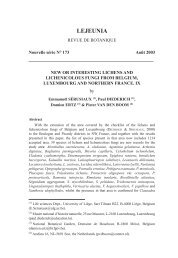The Lichens and Lichenicolous Fungi of Belgium and Luxembourg ...
The Lichens and Lichenicolous Fungi of Belgium and Luxembourg ...
The Lichens and Lichenicolous Fungi of Belgium and Luxembourg ...
You also want an ePaper? Increase the reach of your titles
YUMPU automatically turns print PDFs into web optimized ePapers that Google loves.
THE LICHENS OF BELGIUM AND LUXEMBOURG. AN ANNOTATED CHECKLIST 177<br />
Saxicolous, on s<strong>and</strong>stone rocks, or corticolous, on<br />
Alnus <strong>and</strong> Pyrus.<br />
B - . L Lorr.: RR.<br />
<strong>The</strong> identity <strong>of</strong> the material is doubtful <strong>and</strong> requires<br />
further studies.<br />
Lit.: Di: 47, L3: 26.<br />
inundata (Fr.) Sérus. & Diederich<br />
Syn.: Bacidia inundata (Fr.) Körb., Bacidina inundata<br />
(Fr.) Vězda<br />
On ± calcareous rocks in humid <strong>and</strong> shaded conditions,<br />
<strong>of</strong>ten in streams.<br />
B Ard.: RR. L Ard.: RRR, Lorr.: RR.<br />
Lit.: Mü1: 144, NL97: 39.<br />
Bacidia neosquamulosa Aptroot & van Herk<br />
On Populus at margin <strong>of</strong> a Picea plantation.<br />
B Fl.: RRR. L - . Probably overlooked.<br />
Lit.: Aptroot & van Herk (1999).<br />
Bacidia phacodes Körb.<br />
Syn.: Bacidina phacodes (Körb.) Vězda, Bacidia<br />
albescens (Stizenb.) Bausch<br />
On Acer campestre in sheltered <strong>and</strong> humid forests.<br />
B Mosan: RR. L - . Probably overlooked.<br />
Lit.: L5: 14-15, NL84: 12, van den Boom & Sérusiaux<br />
(1996: 22).<br />
Bacidia saxenii Erichsen<br />
On walls, stones, gravestones, normally in ruderal<br />
conditions, also on slate debris in a disused quarry.<br />
B Fl.: RRR. L Ard.: RRR, Lorr.: RRR.<br />
<strong>The</strong> report <strong>of</strong> this species from B Camp.: RRR by<br />
NL93: 42 is erroneous, the specimen belonging<br />
to a possibly undescribed species.<br />
Lit.: L8.<br />
fusarioides D. Hawksw., Poelt & Tscherm.-Woess, see W.<br />
arnoldiana<br />
XANTHOPARMELIA (Vain.) Hale<br />
conspersa (Ach.) Hale<br />
Syn.: Parmelia conspersa (Ach.) Ach., P. stenophylla<br />
auct., non (Ach.) Heugel, nom. conf., P.<br />
molliuscula auct. belg. p. p., non Ach.<br />
On exposed, siliceous rocks, on walls or ro<strong>of</strong>s,<br />
exceptionally on s<strong>and</strong>stone rocks, once found on<br />
dust-enriched bark.<br />
B Brab.: RR, Mosan: AC, Ard.: AC. L Ard.: AC,<br />
Lorr.: RRR.<br />
<strong>The</strong> report <strong>of</strong> X. angustiphylla (Gyeln.) Hale from<br />
B by Hale (1990: 68) refers to non-isidiate forms<br />
<strong>of</strong> X. conspersa. <strong>The</strong> genuine X. angustiphylla<br />
does not occur in the study area.<br />
Lit.: La66: 432-433, Diederich (1985a: 23), Lambinon &<br />
Sérusiaux (1985b: 207).<br />
mougeotii (D. Dietr.) Hale<br />
Syn.: Parmelia mougeotii D. Dietr.<br />
Saxicolous, on exposed, siliceous or s<strong>and</strong>stone<br />
rocks <strong>and</strong> stones, in natural habitats <strong>and</strong> on slate<br />
debris in old quarries, also on walls.<br />
B Mosan: RR, Ard.: AR. L Ard.: AR, Lorr.: RR.<br />
Lit.: La66: 433-434, Lambinon & Sérusiaux (1985b: 209).<br />
protomatrae (Gyeln.) Hale<br />
Syn.: Parmelia protomatrae Gyeln.<br />
On a dry <strong>and</strong> sunny, natural, slightly calcareous,<br />
siliceous outcrop.<br />
B Mosan: RRR. L - .<br />
Lit.: Schl: 240 (probably a mistake for var. somloënsis,<br />
see L8), Lambinon & Sérusiaux (1985b: 209-210).<br />
somloënsis (Gyeln.) Hale var. somloënsis<br />
Syn.: X. taractica (Kremp.) Hale, Parmelia taractica<br />
Kremp., P. stenophylla auct. p. m. p., non (Ach.)<br />
Heugel, nom. conf.<br />
On dry <strong>and</strong> sunny, natural outcrops <strong>of</strong> siliceous rocks.<br />
B - . L Ard.: RRR. F Mosan: RRR.<br />
Lit.: L8, Schl: 134, 240, Lambinon & Sérusiaux (1985b: 210).<br />
angustiphylla (Gyeln.) Hale, see X. conspersa<br />
incurva (Pers.) Hale, see Arctoparmelia incurva<br />
XANTHORIA (Fr.) Th. Fr.<br />
<strong>The</strong> specimens referred to X. c<strong>and</strong>elaria <strong>and</strong> X. fallax<br />
should be re-examined, as the recently circumscribed<br />
X. fulva (H<strong>of</strong>fm.) Poelt & Petutschnig <strong>and</strong><br />
X. ulophyllodes Räsänen are likely to occur in the<br />
study area (Poelt & Petutschnig 1992).<br />
calcicola Oxner<br />
Syn.: X. aureola auct., non (Ach.) Erichsen<br />
Saxicolous, exceptionally corticolous, in natural<br />
<strong>and</strong> artificial habitats, always in nitrophilous<br />
conditions.<br />
B Mar.: CC, Fl.: AR, Camp.: AR, Brab.: AR, Mosan:<br />
AC, Ard.: AR, Lorr.: R. L Ard.: AR, Lorr.: AR.<br />
Lit.: Ho: 241, La66: 468, VGH: 114, Duvigneaud &<br />
Lambinon (1963: 47).<br />
c<strong>and</strong>elaria (L.) Th. Fr.<br />
Syn.: X. lychnea (Ach.) Th. Fr.<br />
Corticolous, nitrophilous, on roadside trees, in orchards,<br />
etc., <strong>of</strong>ten at the base <strong>of</strong> trunks, rarely saxicolous.<br />
B Mar.: CC, Fl.: CC, elsewhere: AC-C. L Ard.: AC,<br />
Lorr.: AC.<br />
Lit.: Ca: 167-168, Ho: 243, La66: 464, Qu: 125-127, WS:<br />
60-61, 116.





